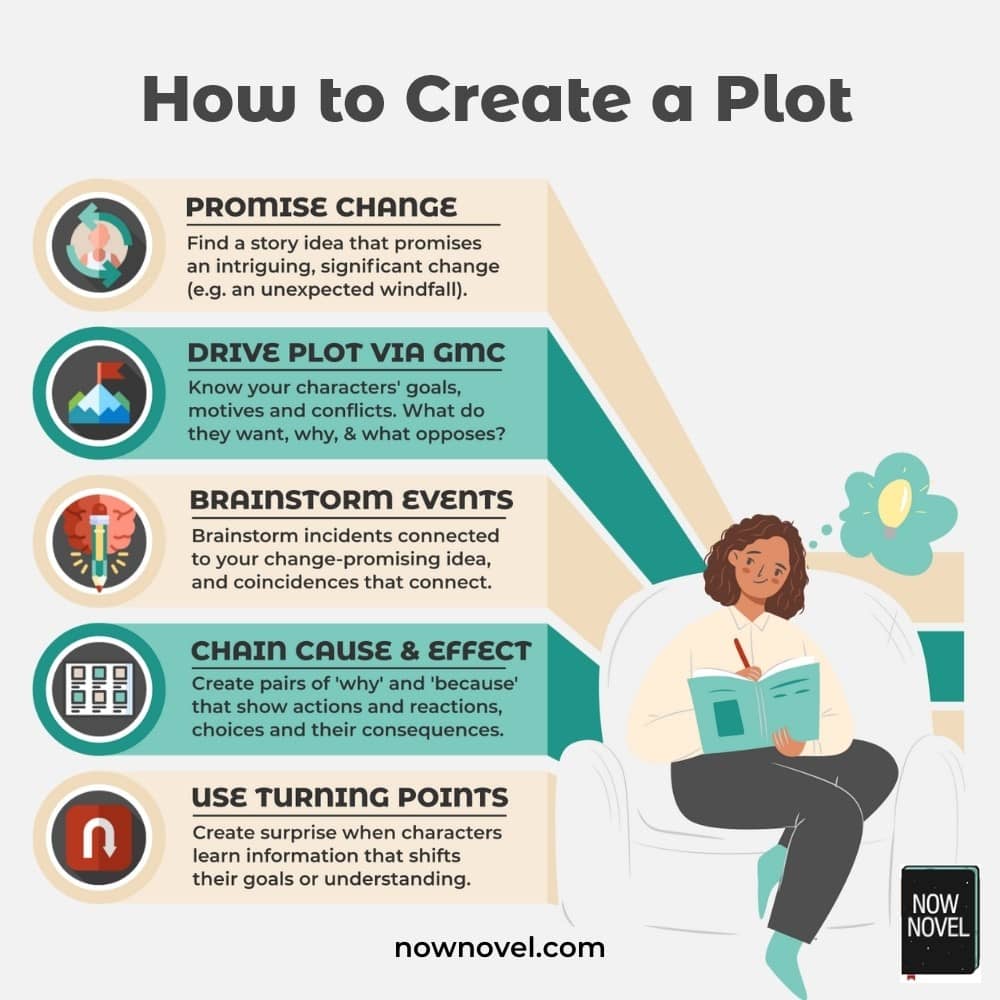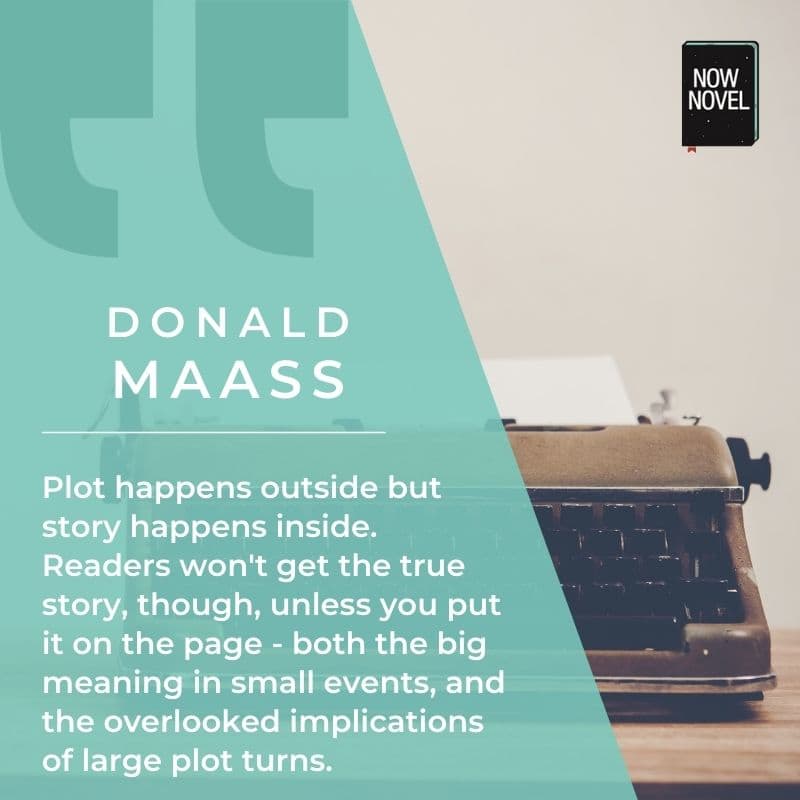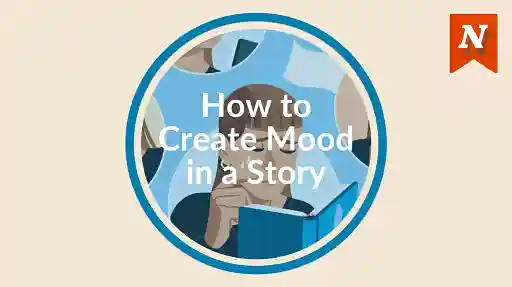Acclaimed authors have often said that it's not plot that matters, but rather story. Yet knowing how to create a plot that uses universal storytelling elements such as action and reaction, incident and coincidence, helps you grab and keep your reader's attention. Learn how to come up with a plot for a better story:
How to create plots: 5 ideas:
- Create plot ideas promising change
- Drive plot with GMC
- Brainstorm incidents and coincidence
- Chain cause and effect
- Surprise using turning points
Let's explore these plotting ideas further:
Create plot ideas promising change
Plot is described in many ways, often disparagingly as a concept. Ray Bradbury calls it 'no more than footprints left in the snow after your characters have run by on their way to incredible destinations' (in Zen in the Art of Writing).
In On Writing, Stephen King describes plot as 'shifty', comparing it to 'honorable and trustworthy' story.
Whatever your views on plot, there's one thing all great plot ideas and summaries have in common: The promise of interesting and suspenseful change in a sequence of events.
Examples of plot ideas that promise intriguing change
Take a successful story like Roald Dahl's beloved classic Charlie and the Chocolate Factory, for example. It's spawned multiple film adaptations due, in part, to its effective plot.
'Charlie buys chocolate bar' is not a plot. It's a simple, commonplace action.
What about: 'Underprivileged Charlie buys a chocolate bar that contains one of five tickets to tour a mysterious, reopened chocolate factory that is owned by an eccentric recluse who is secretly planning to bequeath his empire to one of the tickets' lucky winners'?
This is a plot. Plot connects events to create a web of meaning and possibility. Signs, incidents, and their connections. Mystery and suspense.
A two-line plot summary of a story should tease intriguing, possible change.
Take these examples from Hawes' monthly list of NYT bestselling fiction:
- Maggie Dawes, a renowned travel photographer, struggles with a medical diagnosis over Christmas (The Wish by Nicholas Sparks).
- The Delaney siblings suspect their father of causing the disappearance of their mother (Apples Never Fall by Liane Moriarty).
- Ray Carney, a family man who sells furniture on 125th street, gets a new clientele made up of vicious and unsavoury characters (Harlem Shuffle by Colson Whitehead).
Each of these summaries clearly promises change.
There is clear potential emotional impact implied for central characters (difficult diagnoses, familial betrayal, or challenges that come with 'unsavoury' clients for a business owner).
Each implies a before and after, helping us to start imagining incidents, actions, reactions and coincidences that will make these lives real.

Drive plot with GMC
Learning how to create a plot requires understanding a vital trinity: GMC. Goal, motivation, and conflict.
Bradbury may have said that plot is nothing but footprints left by your characters, yet there would be no footprints without that initial goal - your characters wanting to leave in the first place.
Or their motivations: Why your characters want to go to a specific destination, the root desire propelling their adventures.
Plus, perhaps most importantly for plot, the conflicts characters might encounter along the way.
Examples of how to create plot using GMC
Let's take one of the three examples above of plot ideas that promise change:
The Delaney siblings suspect their father of causing the disappearance of their mother.
Next, we might brainstorm the siblings' shared goal: Finding out what happened to their mother.
Then, we could brainstorm individual goals. Maybe the direct, headstrong sibling wants to confront their father outright and ask hard questions.
Their non-confrontational younger sibling wants to look through their mom's correspondence for signs or clues about their mother's frame of mind at the time of her disappearance.
These differences in personal goals could spin off their own conflicts, as the siblings argue about the correct course of action. Or the narrative might branch as each conducts their own investigation.
Tie characters' goals back to what you've brainstormed or imagined about their personalities. What are they like? Given the exact same circumstances, how might three siblings respond or react differently based on what they know, believe or value?
To find character motivations to drive your plot, ask why your characters have the goals they do. Maybe the sibling who wants to go through her mother's things for clues remembers her mother writing a letter in a secretive manner, and covering up what she was writing when interrupted.
Brainstorm incidents that show and suggest goals, motivations, and conflicts. As well as mysterious unknowns, secrets and lies.
Brainstorm incidents and coincidence
'Incidents' and 'coincidence' are two valuable building blocks of plot.
An incident is something that happens (or has happened) that is significant. It casts a net of meaning over a day, or a life, like the Delaney sisters' mother disappearing.
Any successful story will keep core incidents fairly connected to the root idea (such as a disappearance) given in the book's blurb. Plot requires connectedness or cohesion.
Coincidence is valuable for creating plot, because it weaves in the accidental or unexpected. The mysterious or unpredictable 'meanwhiles' that also occur while something else is unfolding.
An 'incident' is the Delaney siblings' mother going missing.
A coincidence could be a family friend saying they saw the Delaney siblings' father filling up at a gas station a little out of town, around the time their mother went missing.
It creates the question (for the siblings and the reader), 'Is it possible that this other incident, this coincidence, is connected?' Or, if the connection is clear, it supplies a further important detail that drives the story forward.
Example of creating plot via incident and coincidence: Crime and Punishment
In Fyodor Dostoevsky's classic novel Crime & Punishment, the main character Rodion is a penniless student who murders a pawnbroker.
This murder is the incident that sets the story in motion, occurring early in the novel. Rodion manages to convince himself he is committing a noble act due to the way (in his eyes) the pawnbroker exploits others' suffering and need.
The coincidence that adds further tragic depth to the story is that the pawnbroker's half-sister returns to the pawnbroker's flat, catching Rodion in the act. As she is witness to his crime, Rodion kills her too in panic, and this means his 'code' rationalizing his crime to himself falls apart.
Lizaveta, the sister, is an innocent person who Dostoevsky shows us is caring and kind (in contrast to the pawnbroker), and not someone Rodion ever wished harm.
Dostoevsky takes an already damaging and dramatic situation and uses the coincidence of Lizaveta's presence to complicate Rodion's goals, motives and internal conflict further. This in turn leads to even more internal conflict and angst for the protagonist, his guilt now compounded.
Chain cause and effect
To learn how to create a plot, you have to befriend 'because'.
Why does Odysseus take so long to return home that his wife barely recognizes him in Homer's Odyssey? Because the God Poseidon is furious Odysseus blinded his cyclops son. So Poseidon creates obstacles, creates trouble. And as Odysseus sails homeward, trouble generates further trouble. In other words, good plot links action and reaction.
As Now Novel coach Romy shared in our writing webinar on structuring action and reaction in your story:
It doesn't matter if you're a plotter or a pantser, ask yourself how each scene contributes to the cause-and-effect forward motion of the story.
Romy Sommer, 'Action and reaction: Structuring scenes and chapters'
Plot builds via a sequence of events that connect cause and effect. Your reader asks 'why?'; plot answers 'because' (and carries on creating burning questions).
So how do you find cause and effect ideas to come up with a plot?
- Write down a mid-point or end-point incident or scenario (e.g. 'Maggie Dawes, a renowned travel photographer, struggles with a medical diagnosis over Christmas').
- Go digging in 'who', 'what', 'why, 'where' or 'when' to imagine a cause preceding this incident ('Maggie went to the doctor as she was experiencing troubling symptoms after returning from a travel assignment').
- Keep searching backwards from events to find a chain of cause and effect (for example, the reason Maggie left it until Christmas to see the doctor; what else is going on that complicates the situation).
Example: Chaining cause and effect in A Game of Thrones
In A Game of Thrones, the first in George R. R. Martin's series that became the hit TV show, three storylines unfold simultaneously.
One storyline involves Jon Snow, who joins the Night's Watch but finds it is not what he expected.
To summarize this chain of cause and effect:
First Cause: Jon Snow, inspired by his uncle Benjen, joins the Night's Watch which patrols the border north of the Seven Kingdoms.
First effect: Jon is disillusioned when he discovers that the Night's Watch functions as a harsh penal colony.
Second effect: Jon unites other recruits against their sadistic instructor and protects another vulnerable recruit, Samwell.
The effect of Jon joining the Night's Watch is that he learns its true, unpleasant nature, and makes new choices based on this revelation.
Making new choices due to a revelation is typical of a turning point:

Surprise using turning points
Turning points make stories intriguing because they often serve us what we don't expect. We see a cause, and we expect one effect, but what follows zigs and zags.
In the example above, Jon Snow's discovery of the Night Watch's true nature is a turning point. He must set aside what he thought to be true and choose an altered path given the new awareness he has gained.
In learning how to create a plot, familiarize yourself with the types of turning point common in your genre.
In romance, for example, turning points arise due to situations and assumptions affecting intimacy. Characters may be suddenly separated by war or a less dramatic intervention. The love interest not being exactly who the main character thought might send them scuttling for safety.
In a murder mystery, by contrast, turning points will arise most commonly in the investigation of the case. Sudden turns in who is a suspect or who is given a last-minute alibi. Innocent bystanders suddenly seem not as innocent as evidence adds up.
Turning points may arise from your characters' goals changing unexpectedly due to new circumstances (like Katniss' sacrifice in the example below). Or they may occur due to collision between characters and their goals.
For example, a detective is close to cracking a case but then their interfering department head recalls them due to a rookie mistake.
Turning point example: Katniss' initial sacrifice in The Hunger Games
In a helpful article on creating turning points, C.S. Lakin describes how early the first major turning point occurs in Suzanne Collins' adventure/sci-fi series:
Writers often ask me: Where should I start my story? Easy-peasy. Start right before the inciting incident. Next question?
You don’t need to take all that much time for setup, even in a fantasy novel. You just need enough to introduce the protagonist, her core need, the stakes and conflict for the story (personal and public), and the other key players in the story.
The Hunger Games is a great example. We have the opening scenes showing Katniss with her family, showing the world situation, showing her skill at hunting, showing the two key male characters that will be her love interests. And, boom! The reaping takes place, her sister is chosen for the deadly games, and Katniss volunteers as Tribute in Prim’s place.
C.S. Lakin, 'The 5 Turning Point in Your Novel', March 29 2021.
Now that we've explored some basic concepts for how to create a plot, read ten ways to develop your plot into a substantial, enthralling story. Learn more about ways you can use Now Novel to outline your plot, too.
Get an organized plotting process plus weekly writing feedback and monthly webinars with coach Q&As when you become a premium Now Novel member.










This blog is really outstanding. Appreciate your efforts Jordan. Thanks a lot
Usman - About 3 years ago
Hi Usman, thank you for your kind feedback and for reading our blog! It's a pleasure.
Jordan - About 3 years ago